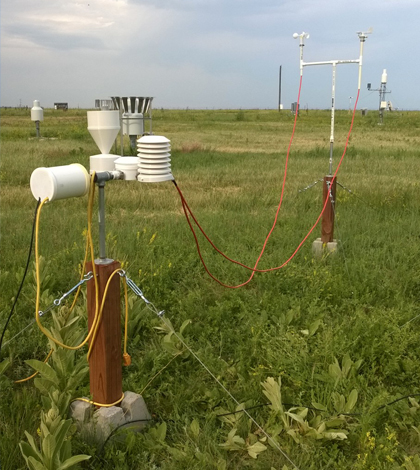3D Printing Could Provide Reliable Weather Stations For Developing World

A 3D-printed weather station sits in a test field. (Credit: Martin Steinson, University Corporation for Atmospheric Research)
Since 3D printing became possible, the technology has been lauded for all the potential it holds to make things. Virtually anything conceivable, including figurines, car parts and even prosthetics, can now be made with the right design and the push of a button.
Scientists at the University Corporation for Atmospheric Research are looking to leverage some of that potential in a project to build weather stations with 3D printers. Not just a pet project, the researchers are being funded by the U.S. Agency for International Development with plans to scale up the work to provide weather stations in remote areas of the world that lack them.
Their efforts are utilizing 3D-printed parts, off-the-shelf sensors and raspberry pi microcontrollers to support a system that can be easily replicated and maintained wherever it’s stationed. Much of the work is in the beginning stages at this point.
“The idea came from the twisted mind of my colleague, Kelly Sponberg. He’s been involved with these issues for some time,” said Martin Steinson, a project manager at UCAR. Sponberg is a technologist with the organization. “He explained the issues in Africa where the stations break and nobody is there to fix them. And he told me about the idea and I thought he was a nut.”
Sponberg, who has worked extensively in Zambia, has seen firsthand the need for such a system in parts of the world, like Africa, where funding for weather monitoring is scarce and expertise for maintaining the stations is lacking. Steinson points out other regions of the world, where weather data are sparse, that could benefit from the systems. These include the rest of Africa, many areas in the Caribbean and the developing world overall.

A 3D-printed weather station sits in a test field. (Credit: Martin Steinson, University Corporation for Atmospheric Research)
“We would be working with the weather service of the country — in Zambia, it would be the Zambia Meteorological Department. They’ll be the makers and owners of the things,” said Steinson. “This is one of the biggest advantages we see on this setup. They can just make the components they need and take them out there with them. It’s a real advantage to this idea.”
In explaining how the stations would work, Steinson says that sensors would send data to the raspberry pi controller. The controller would collect the data and do some of the post processing to turn the readings into something easily understood by meteorologists. From that point, data would be transmitted via some form of telemetry, depending on the area. Some stations would use cell signals, radio, or even Wi-Fi if it’s available. For the most-secluded locations, a memory card would serve to gather the data directly.
The 3D-printed stations would come in at a cost much lower than high-end ones available on the market today. Part of that is because of the materials they can be printed of, including petroleum- and corn-derived materials. But that doesn’t stop the duo from trying to make their stations just as capable. Plans are to make the systems able to measure barometric pressure, air temperature, humidity, wind speed and direction and rain. The configuration is perfect for the areas targeted in the work, says Steinson, because they don’t get much snow anyway.
To assess how the printed stations stack up against popular weather stations, Steinson and Sponberg have set up a working prototype alongside one used at a UCAR facility.
“We’re doing that at the moment. We put out one in March at a test field. At the moment, we’re comparing it with the equipment they have, which is really high-end. It’s still collecting data,” said Steinson. “We’re hoping to put another one in the National Weather Service testing center in Sterling, Va., to get a second set of data for that purpose.”
Next steps for the project will see Steinson and Sponberg heading to Zambia, where they will take advantage of Sponberg’s connections to launch a station.
“We’ll provide the equipment for the manufacturing and teach them how to manage the station, maintain and repair it if needed,” said Steinson. “They’ll start making them and we’ll be invested in supporting them through the whole process.”
Some of their other colleagues have proposed adopting the 3D-printing approach to advance air quality monitoring work to look at breathable pollutants in cities across the world.
“We would even like to expand the sensors we have in our weather stations to make them more useful in agriculture,” said Steinson. “For example, monitoring soil moisture, that type of thing.”
Top image: A 3D-printed weather station sits in a test field. (Credit: Martin Steinson, University Corporation for Atmospheric Research)




0 comments